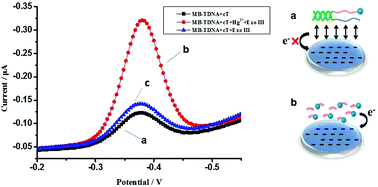A homogeneous electrochemical sensor for Hg2+ determination in environmental water based on the T–Hg2+–T structure and exonuclease III-assisted recycling amplification
Abstract
A simple, fast, sensitive, and homogeneous electrochemical sensor based on the T–Hg2+–T structure and exonuclease III-assisted recycling amplification has been constructed for mercury ion (Hg2+) detection. The cT and methylene blue-labeled DNA probes (MB-TDNA) were designed to contain poly T sequences, which were repulsed from the negatively charged indium tin oxide (ITO) electrode due to their abundant negative charges. Hg2+ could trigger the formation of double-stranded DNA (dsDNA) between two DNA probes owing to the stable T–Hg2+–T structure. Then, Exo III specifically recognizes the cleavage of the double-stranded structure to release a methylene blue-labeled mononucleotide fragment (MB-MF). Moreover, the release of the target Hg2+ induces new hybridization and produces a large number of MB-MFs; MB-MFs are not repulsed by the negatively charged ITO electrode surface, thus producing a significant current signal. Under optimal conditions, the differential pulse voltammetric (DPV) response had a linear relationship with the logarithm of Hg2+ concentration in the range of 1.0 nM–0.5 μM, and the proposed method displayed great applicability for detecting Hg2+ in tap-water samples.



 Please wait while we load your content...
Please wait while we load your content...